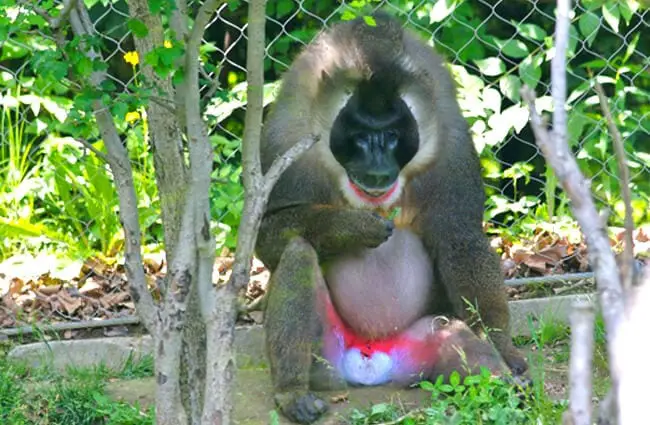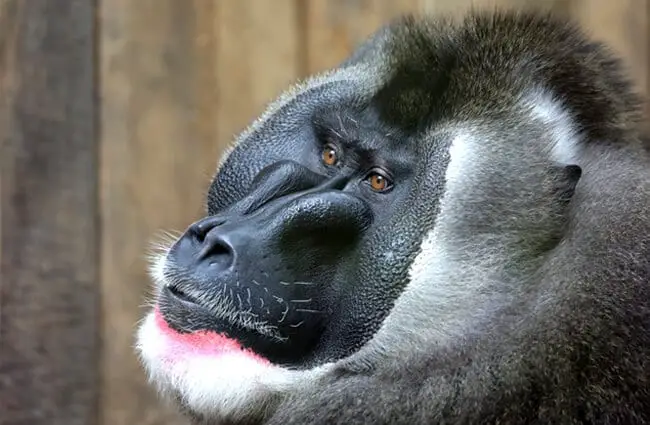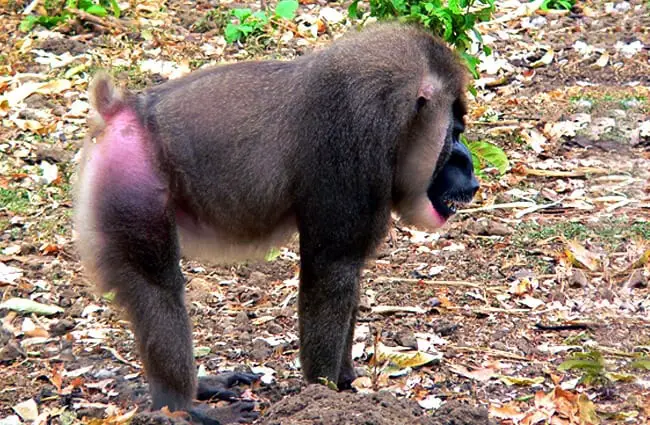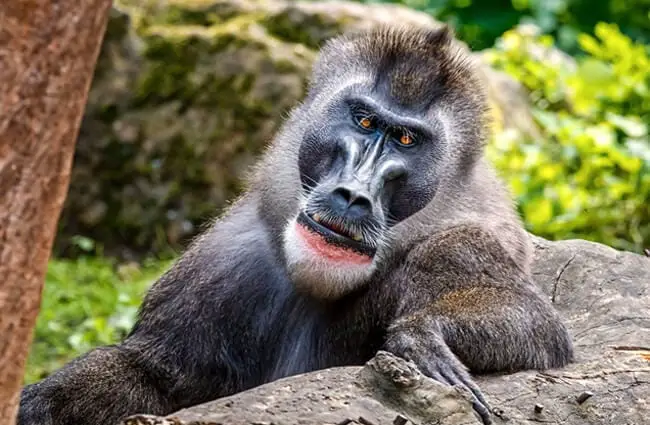Meet the Drill: Africa’s Colorful and Endangered Primate
Few primates boast such a striking appearance as the drill, a robust forest dweller found in a limited range of West and Central Africa. With its vibrant facial coloration and powerful build, this primate is a fascinating subject for both scientific study and public admiration. Often referred to as one of the larger African monkeys, the drill plays a crucial role in its ecosystem, but faces increasing threats to its survival. This guide delves into the world of the drill, exploring its habitat, behavior, evolutionary history, and the challenges it faces.

Habitat and Distribution
Drills are primarily found in the rainforests, swamp forests, and mountainous forests of Nigeria, Cameroon, Gabon, and parts of the Democratic Republic of Congo. They prefer dense, primary forests but can adapt to secondary forests and even selectively logged areas. Their distribution is fragmented, meaning populations are separated by unsuitable habitats. This fragmentation is a major concern for conservation efforts. Drills thrive in areas with abundant fruit, seeds, and insects, essential components of their diet.
Physical Characteristics
The drill is a powerfully built primate, with males significantly larger than females – a trait known as sexual dimorphism. Males can weigh between 50 and 90 pounds, while females typically weigh between 25 and 40 pounds. Their most distinctive feature is their striking facial coloration. The muzzle is black, contrasting sharply with the bright red or pink nose and lips. The face itself is a mixture of blues, purples, and pinks, providing a truly unique appearance. Their thick fur is typically dark brown or black. Powerful jaws and large canine teeth are adapted for cracking hard nuts and seeds.

Diet and Foraging Behavior
Drills are omnivorous, with a diet that primarily consists of fruits, seeds, insects, leaves, and occasionally small vertebrates. They are known for their ability to crack open hard-shelled nuts and seeds using their powerful jaws. They spend a significant portion of their day foraging on the forest floor, often traveling long distances in search of food. They are also skilled at digging for roots and tubers. Their diet varies seasonally, depending on the availability of different food sources. They are essential seed dispersers, playing a vital role in maintaining forest biodiversity.
Social Structure and Behavior
Drills live in multi-male and multi-female groups, typically ranging from 20 to 50 individuals. These groups are led by a dominant male, who maintains order and protects the group from threats. Social bonds are strong, and individuals engage in grooming, play, and cooperative foraging. Communication involves a variety of vocalizations, facial expressions, and body postures. They are known for their boisterous and playful behavior. Dominance hierarchies exist within the group, influencing access to food and mating opportunities.

Reproduction and Life Cycle
Females typically reach sexual maturity around the age of six, while males mature around eight. Mating is not strictly seasonal, but births tend to peak during the rainy season when food is more abundant. Gestation lasts approximately five to six months, resulting in the birth of a single infant. Infants are completely dependent on their mothers for the first few months of life, clinging to their mother’s belly or back. Weaning occurs around one year of age. Infants and juveniles engage in playful behavior, learning essential skills from their mothers and other group members. Life expectancy in the wild is estimated to be around 20 to 25 years.
Evolutionary History
The drill belongs to the Old World monkey family, subfamily Cercopithecinae, and the genus Mandrillus, which also includes the mandrill. Fossil evidence suggests that the drill lineage diverged from other species within Mandrillus several million years ago. Their evolutionary adaptations reflect their specialized foraging behavior and terrestrial lifestyle. Genetic studies show that recent population declines have reduced genetic diversity, making them more vulnerable to disease and environmental changes. Understanding their evolutionary history is crucial for developing effective conservation strategies.

Ecological Role and Interactions
Drills play a vital role in their ecosystem as seed dispersers and forest regenerators. Their foraging behavior helps to distribute seeds throughout the forest, promoting plant diversity. They also help to control insect populations. They often coexist with other primate species, such as chimpanzees and gorillas, sometimes sharing foraging grounds. They may also compete for resources, particularly during times of scarcity. They are preyed upon by leopards and other large carnivores, but their size and social behavior provide some protection. Their presence is an indicator of a healthy forest ecosystem.
Threats and Conservation Status
The drill is classified as endangered by the International Union for Conservation of Nature (IUCN). The primary threats to their survival are habitat loss due to deforestation, hunting for bushmeat, and fragmentation of populations. Deforestation for agriculture, logging, and mining is rapidly destroying their forest habitat. Hunting for bushmeat remains a significant problem in many areas. Fragmented populations are more vulnerable to disease and genetic decline. Conservation efforts include habitat protection, anti-poaching patrols, community-based conservation programs, and captive breeding programs.

Drills and Humans
Historically, drills have been hunted for bushmeat and, to a lesser extent, for their skin. Today, the biggest impact of human activity comes from habitat destruction. However, there are increasing efforts to promote coexistence between humans and drills. Community-based conservation programs aim to empower local communities to protect drill habitat and reduce poaching. Ecotourism can also provide economic incentives for conservation. Raising awareness about the plight of the drill is crucial for garnering support for conservation efforts.
Encountering a Drill in the Wild
If you are fortunate enough to encounter a drill in the wild, it is important to maintain a safe distance and observe them respectfully. Avoid making direct eye contact, as this can be perceived as a threat. Do not approach or attempt to feed them. If they approach you, remain calm and slowly back away. Report any sightings to local conservation authorities. Remember that drills are wild animals and should be treated with caution and respect.
Caring for Drills in Captivity
Caring for drills in captivity requires specialized knowledge and resources. They need spacious enclosures that mimic their natural habitat, with plenty of climbing structures and foraging opportunities. Their diet should be carefully formulated to meet their nutritional needs. They require regular veterinary care and enrichment activities to stimulate their minds and bodies. Social interaction with other drills is essential for their well-being. It’s crucial to provide them with a stimulating and enriching environment that allows them to express their natural behaviors. A deep understanding of their complex social dynamics is vital for successful captive management.

Fascinating Facts About Drills
- Drills have been known to use tools, such as sticks, to dig for food.
- Their brightly colored faces are thought to play a role in communication and social signaling.
- Drills can swim, and have been observed crossing rivers and streams.
- They are highly intelligent and adaptable primates.
- The drill’s scientific name, Mandrillus leucophaeus, refers to its white forehead.
The drill, with its striking appearance and vital ecological role, is a treasure of the African rainforest. Protecting this endangered primate requires a concerted effort from conservationists, governments, and local communities. By understanding their biology, behavior, and threats, we can work together to ensure their survival for generations to come.

![Red Angus Closeup of a beautiful Red Angus cowPhoto by: U.S. Department of Agriculture [pubic domain]https://creativecommons.org/licenses/by/2.0/](https://animals.net/wp-content/uploads/2020/03/Red-Angus-4-238x178.jpg)




![Red Angus Closeup of a beautiful Red Angus cowPhoto by: U.S. Department of Agriculture [pubic domain]https://creativecommons.org/licenses/by/2.0/](https://animals.net/wp-content/uploads/2020/03/Red-Angus-4-100x75.jpg)

